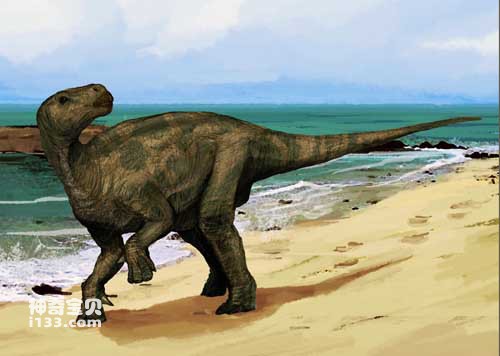Iguanodon is the first dinosaur to be officially discovered, but it is not the first dinosaur to be named. It is the second dinosaur to be named after Megalodon (1824).
Mantel was a family doctor in Lewes, Sussex, England. He and his wife Marianne discovered Iguanodon, which means "iguana's tooth" (this is 16 years before the word dinosaur appeared). Since the discovery of Iguanodon, people have slowly begun to realize that some huge and daunting animals once lived on the earth we live on.
At that time, using the size of living iguana teeth as a reference, Professor Owen of Oxford University speculated that the length of Iguanodon was 30 to 60 meters, which was as big as half a football field! Later, Mantel and many amateur researchers continued to dig, and it took 15 years to discover fossils of vertebrae, ribs and many other bones. The size of these bones forced Professor Owen to change his earliest inferences and reduce the length of Iguanodon to 7 meters. These fossils also show that Iguanodon was much larger and heavier than modern monitor lizards; the structure of its sternum was similar to that of crocodiles, suggesting that it had four ventricles, which was more advanced than the three ventricles of other reptiles. Therefore, Professor Owen believes that the heart and circulatory system of Iguanodon are almost the same as those of warm-blooded vertebrates.
Fossils also show that Iguanodon was a social animal. In 1878, in Benisat, a small town in Belgium, coal miners encountered a pile of fossilized bones while working in a mine 322 meters underground. This is the skeleton of an Iguanodon! In the end, 39 Iguanodon skeletons were found there, pieced together like a giant jigsaw puzzle. These complete Iguanodon skeletons can still be seen in the Royal Museum of Belgium.
They always form a small group and wander around in search of food. A large number of iguanodon footprint fossils have been found in many places. Through these footprint fossils, we can learn a lot of information about their number, walking method, movement speed, age and so on.

Chinese name: Iguanodon
Latin name: Iguanodon
Life time: Early Cretaceous
Fossil origin: Belgium, Britain, Germany, North Africa, China
Physical characteristics: 9~10 meters long
Diet: plants
Species: Ornithopods
Definition: iguana's teeth
animal tags: Iguanodon
We created this article in conjunction with AI technology, then made sure it was fact-checked and edited by a Animals Top editor.